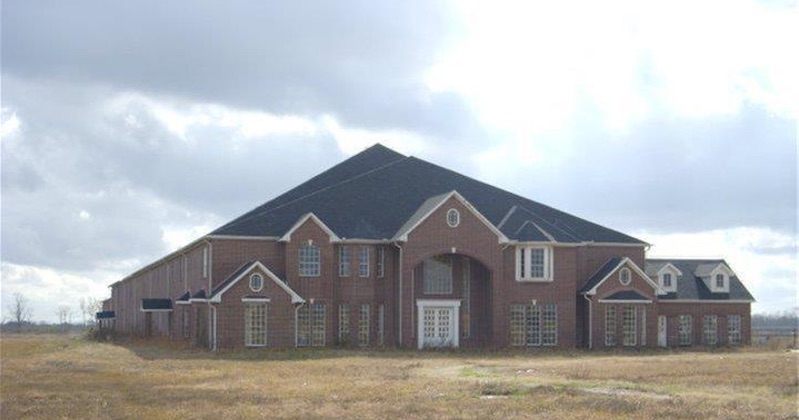The Abandoned Medical Facilities of the Future

A giant house, meant to be a rehab center, never finished (Photo: Christy Buck)
The empty building on Country Road 59, on the very fringes of the Houston metro area, looks less like a medical facility than a really, really big house. It was meant, originally, to serve as a rehab facility, complete with a swimming pool and indoor spa, and while the listing says it has 46 bedrooms, the realtor who’s selling the building told the Houston Chronicle that it’s possible there could be as many as 70.
The interior of the building was never finished, and the pictures of the inside are almost the inverse of more common photographs of abandoned medical facilities—the grass outside grows tall, and the walls, in places, are dusted with cobwebs, but otherwise the rooms are relatively pristine, since they’ve never been used. Still, it’s haunting in its own way—and it points toward the medical facilities today’s health care system might leave behind for the next generation to wonder at.
In the typology of fascinating places that beg to be explored, derelict medical facilities—sanitariums, insane asylums and other sprawling complexes—are a staple, a way to tour the sometimes frightening and disturbing history of American healthcare. But in the future—say, 75 years from now—what will the equivalent of an decaying asylum be?

Inside the unfinished rehab center (Photo: Christy Buck)
The most direct analogue, at the moment, are rural hospitals, which are closing at an increasing clip in response to the recession and the changing economics of health care: the University of North Carolina’s Rural Health Research Program has documented 84 closures in the past decade, more than half of which occurred within the past five years.
Community hospitals are closing in cities, too, but they are often destined for a particular type of second life, as condos. The rural hospitals that are closing are concentrated in the south, and they have more varied fates. About half of them the research programs considers “abandoned”—they’re no longer being used for any type of health care function. That doesn’t mean, however, that they’re sitting entirely bereft of human contact.
“If it’s abandoned, it might be empty, or it might be used for something else,” says Sharita Thomas, a research associate at the health research program. “It might be a parking garage, that kind of thing.” One community, she says, was considering turning a closed-down hospital into a school.
About half of the rural hospitals that UNC has documented, though, are not considered deserted; they have been converted into some other type of health care facility—often urgent care, senior housing or rehab centers like the empty buildings in Texas. And in cities, too, some buildings that are no longer being used for the original purpose—a parking garage in New York City, a convent in New Jersey, a shopping center in Albany, New York—are actually becoming medical facilities. (Although, conversely, in Des Moines, a former nursing home is being turned into apartments.)
This category of facility—where people live and receive subacute medical care—might include rehab centers, assisted living facilities and nursing homes, and far from being abandoned, right now, these sort of medical facilities are filling up fast: across the country, senior housing has a high occupancy rate, around 90 percent, and the sector’s only growing as life expectancy increases.

An assisted living facility—the abandoned asylum of tomorrow? (Photo: choctawman/Flickr)
Even if they’re full right now, though, assisted living and nursing homes have something in common with asylums of old.
Inside, they have long, anonymous hallways, studded with small rooms, that open up into the occasional large, sweeping space—the dining halls and rec rooms. There are nurses stations, industrial kitchens, and small chapels. They don’t have the restraints and barred rooms of anachronistic psychiatric institutions, but a line of empty wheelchairs and walkers has its own haunting quality. These facilities also have their own form of restrictive technologies: particularly at facilities that specialize in dementia and other cognitive impairments, a wireless system of door locks and wander management systems activated by electronic anklets keep residents from leaving. Of course, there’s also something eerie about places where patients spend nights moaning in pain.
Part of what makes abandoned asylums so compelling is that advances in medical practices shed a new light on older ideas: what was once acceptable seems cruel and wrong in retrospect. Right now, assisted living facilities and nursing homes seem like a decent solution to a pressing problem: people get old, and they need constant care that many families and communities are not set up to provide. But maybe in 75 years, when the science of aging has improved by leaps and bounds, it will seem strange—barbaric, even—that we trapped older people in these suburban mansions and left them there to live out their last years, just as it now seems unthinkable to simply shut people away when they’re mentally ill.







Follow us on Twitter to get the latest on the world's hidden wonders.
Like us on Facebook to get the latest on the world's hidden wonders.
Follow us on Twitter Like us on Facebook